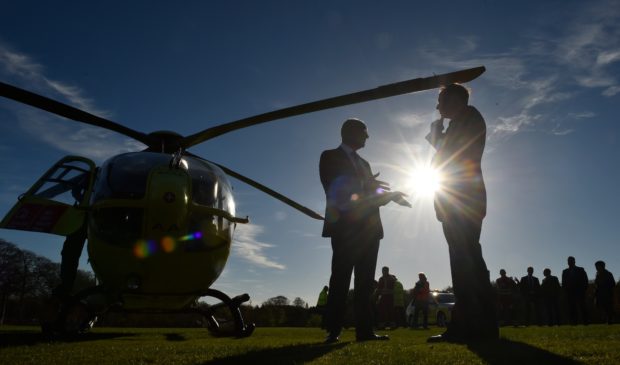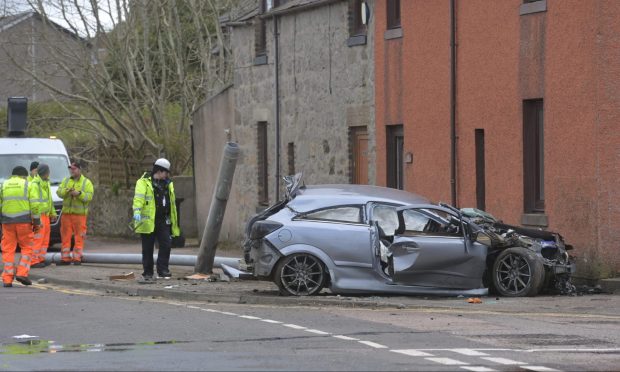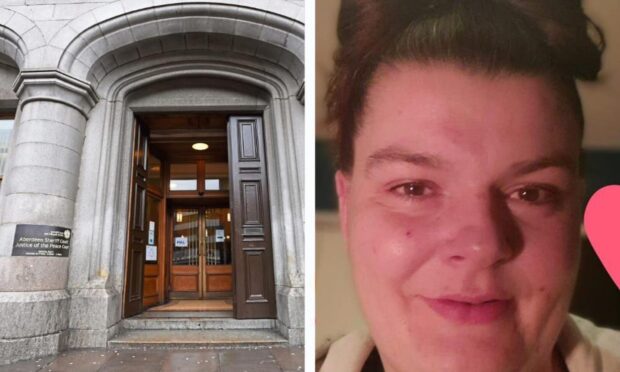Lives will “undoubtedly be saved” across the north and north-east after a new air ambulance arrives in Aberdeen.
Scotland’s Charity Air Ambulance (SCAA) already runs one aircraft from Perthshire – which is scrambled to emergencies across the nation, and earlier this year launched a massive fundraising campaign to buy a second.
Yesterday – after a campaign by the Press and Journal, those rescued by the existing helicopter and politicians – it was announced that the aircraft will be based in Aberdeen.
SCAA hopes to have it running by this time next year, after the £6million required to keep it in the air for three years has been raised.
The board, NHS and Scottish Ambulance Service (SAS) unanimously backed the idea of bringing the helicopter to the north-east due to its rural location.
The aircraft will also be sent north to deal with accidents and emergencies, and SCAA say it will allow them to save “twice as many lives”.
Chairman John Bullough said: “Our distinctive helicopter will soon be a regular sight over Aberdeen, and we hope residents will see it as an essential part of the Granite City.
“It is clear that the new helicopter will have the greatest impact on communities within the Grampian region.
“But it will have an impact far beyond the area, this will transform aviation response times throughout Scotland.
“Its presence will be felt from Orkney to the Borders and from Inverness to the Western Isles, in some of Europe’s most remote communities, and it will allow us to save twice as many lives.”
Though the charity is confident it will have amassed £3million towards the new Helimed 79 copter by the end of the year, it is now in a race against time to secure the remaining 50% to have it in the sky by late 2019.
The £6million target will cover flying costs for its first three years.
Mr Bullough added: “To launch within 12 months, SCAA needs philanthropists, foundations, corporations, charities and hard-working members of the public to to support our campaign.”
SAS chairman Tom Steele added: “Suffering major trauma is the main cause of death for people under 40.
“Being able to bring care to people more quickly, and transport them to an effective trauma centre, will undoubtedly save lives.”
Orkney MSP Liam McArthur previously lodged a motion in parliament supporting the Press and Journal’s campaign to base the aircraft in Aberdeen.
Yesterday, he said: “There is widespread public support for this across the north-east and beyond, and I pay tribute to the campaigning work done by the P&J to highlight this.
“Communities in Orkney are particularly reliant on the air ambulance service, which is a genuine lifeline.
“Anything that helps improve response times and the service overall is therefore particularly welcome.”
North East MSP Lewis Macdonald added: “This helicopter can get from Dyce to Hazlehead in two minutes, the quality of care patients receive in the future will be transformed by it.”
Peter Craigmile, who is a piper for the SAS and pipe major with the Elgin and District Pipe Band, works as an air ambulance paramedic and played as guests arrived at The Park Cafe for yesterday’s announcement at Hazlehead Park.
It was made all the more exciting when the gleaming yellow helicopter circled its way onto the grassy expanse, as a crowd of onlookers gazed skywards and held their mobile phone aloft to capture the moment.
Watching the spectacle were mums and toddlers who had visited the park for an exercise session with the Rebel PT: Prams in the Park fitness group.
Eilidh Gilbert, from Aberdeen, said: “All the kids are delighted, it is quite exciting. As a parent, I am pleased to know we will have this extra facility as and when it is needed.”
Fellow mum, Susie Beattie, said: “It is reassuring there will be extra help on hand and better response times.”
Trauma centre
The newly-opened trauma centre at Aberdeen Royal Infirmary (ARI) was hailed as a major factor in the decision to base the new air ambulance in the city.
The centre will treat people who have suffered life-threatening injuries in road accidents and falls, or have had strokes or heart attacks.
SCAA specialises in getting patients to the most appropriate place for treatment as quickly as possible, which is expected to often be the trauma centre at ARI.
Dr Roland Armes, the emergency medical consultant at ARI who is leading the new trauma centre, said the facility and the air ambulance will radically increase the survival chances of casualties in the area.
He said: “This is another mechanism by which majorly injured patients will be able to reach hospital in a short time-frame.
“We aim to get people to the centre within 40 minutes as time is a really important factor in saving lives.
“The helicopter will be able to circumvent local roads which, at this time of year, are not great to drive on or comfortable for patients.”
Aberdeen Donside MSP, Mark McDonald, added: “With the air ambulance and the trauma centre, we are looking at a situation where – in a couple of years – health services in the north-east will be completely transformed.”
The long-awaited centre is the first of its kind in Scotland, and will form part of a network with Dundee, Glasgow and Edinburgh.
It is thought the trauma centre, at Foresterhill, could potentially save 40 lives a year as the new streamlined approach is rolled out.
Health chiefs last month revealed that all jobs at the unit have already been filled.
Health Secretary Jeane Freeman was on hand when the centre opened and praised the occasion as “an important day in changing trauma care in Scotland for the better”.
Yesterday, she added: “SCAA carries out great work across Scotland, helping to save and improve lives every day. A second helicopter will make a huge difference.
“It is crucial that we ensure the most severely injured patients have the best chance of a speedy recovery from their injuries.”
“This second air ambulance will build capacity to support the trauma centre, contributing to our growing resources in the area.”
The Aberdeenshire man who takes to the skies with SCAA
Aberdeenshire paramedic Richard Forte is better placed than most when it comes to calculating the benefits the new SCAA helicopter will have for the north-east.
The Newtonhill 32-year-old juggles his regular job working as part of the ambulance service’s special operations team, at Bridge of Don, with shifts as a reserve paramedic in the SCAA aircraft based at Scone.
Yesterday, he was aboard the bright yellow copter as it landed at Hazlehead Park.
After stepping from the cockpit, Mr Forte offered guests an insight into how the machine works.
And he said he was looking forward to the prospect of soaring over the region to save life and limb closer to home.
Mr Forte said: “This will help so much, it takes ambulances time to get to accidents and back to Aberdeen, and this will speed things up.
“The majority of the patients will now be going to the trauma centre at ARI, and will be able to get the care they need as quickly as possible.
“There is such unique geography here, with the coast and the mountains and cities, and this helicopter will be able to help people wherever they are.”
Mr Forte was flown into the park by veteran pilot, Pete Martin.
Mr Martin performed a few circles of the area to ensure it was safe to land, before gradually edging the huge machine onto the ground.
The pilot has been working for SCAA for about a year, but has been flying air ambulances for 10 years with Babcock following a 23-year spell honing his skills in the RAF.
He said: “I have flown air ambulances all over the UK, and I know this second one will help the people of Scotland tremendously.
“The paramedics are very experienced, and we all work as a team to ensure patients get the best care.”










